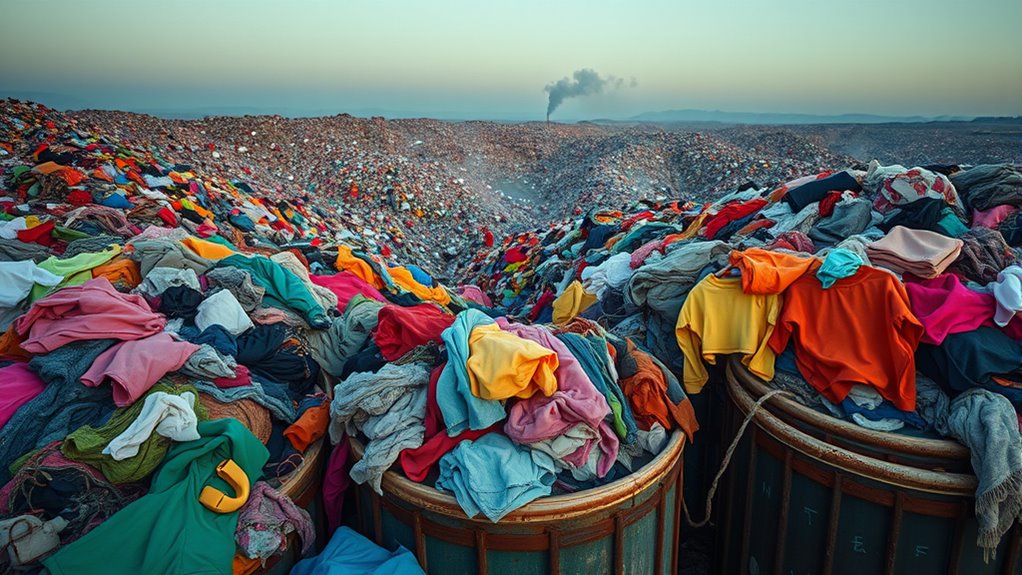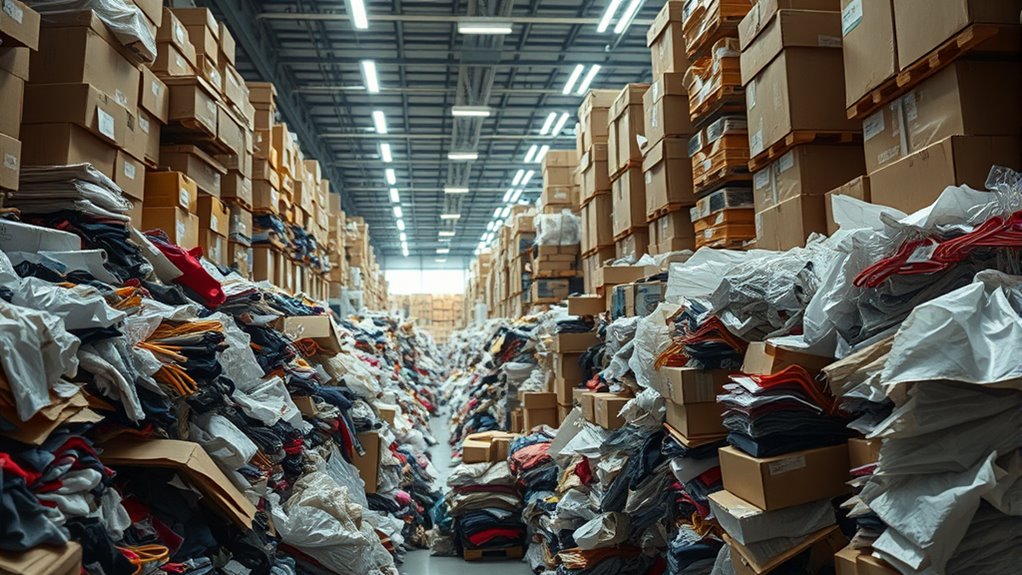When you return fast fashion items, you’re often unknowingly contributing to environmental harm. The production process wastes resources, pollutes water sources, and creates textile waste that ends up in landfills for years. Manufacturing often involves chemicals and low-cost practices that damage ecosystems. Supporting fast fashion fuels this cycle, but opting for sustainable brands or second-hand clothes can reduce your impact. Keep exploring to understand the full extent of these hidden environmental costs and how you can make a difference.
Key Takeaways
- Returning fast fashion items increases transportation emissions, contributing to carbon pollution and greenhouse gases.
- Multiple return shipments lead to higher packaging waste and strain waste management systems.
- Returned garments often get discarded or destroyed, adding to textile waste and landfill overflow.
- Increased returns cause more resource-intensive processing, including cleaning and repurposing, amplifying environmental impact.
- The cycle of returns encourages overproduction, worsening the environmental footprint of fast fashion industries.

Have you ever stopped to contemplate the environmental impact of your fast fashion choices? Every time you buy new clothes, you’re contributing to a cycle that has serious consequences for the planet. One of the most pressing issues is textile waste. Fast fashion encourages rapid consumption, leading to heaps of discarded garments. These clothes often end up in landfills, where they can take years to decompose. During that time, they release harmful chemicals and greenhouse gases, worsening climate change. The sheer volume of textile waste generated by fast fashion brands is staggering, overwhelming waste management systems worldwide. Instead of being recycled or repurposed, much of this fabric simply accumulates, polluting land and water sources.
Water pollution is another critical concern tied to fast fashion. The manufacturing process involves extensive use of water, especially in dyeing and finishing textiles. Many factories discharge untreated or poorly treated wastewater directly into rivers and streams, poisoning aquatic ecosystems. These dyes and chemicals are toxic, and their presence in water sources affects both wildlife and communities relying on those waters for drinking and farming. When you purchase cheap, trendy clothing, you’re indirectly supporting a system that contaminates essential water supplies. Furthermore, the high water footprint of producing fast fashion garments means that water resources are drained at an unsustainable rate, especially in already water-scarce regions. This overuse exacerbates droughts and jeopardizes local livelihoods.
Fast fashion’s emphasis on quick turnover and inexpensive prices also discourages sustainable practices. To keep costs low, many brands cut corners by sourcing materials from regions with lax environmental regulations. This often results in environmental degradation, as factories may dump waste illegally or operate without proper pollution controls. The chemicals used in textile production can seep into groundwater, affecting communities and ecosystems for years to come. As a consumer, your choices can perpetuate this cycle, whether consciously or not. When you buy from fast fashion brands, you’re fueling a system that prioritizes profit over environmental health, leading to increased textile waste and water pollution.
Recognizing these impacts is the first step toward change. By choosing to buy fewer items, selecting higher-quality garments, or supporting brands committed to sustainability, you help reduce textile waste and water pollution. Your purchasing decisions can push the industry toward more responsible practices. Every time you opt for second-hand clothing or invest in timeless pieces, you’re making a statement that sustainability matters. Additionally, supporting sustainable manufacturing practices can help mitigate the environmental costs associated with fast fashion. The hidden environmental costs of fast fashion are undeniable, but your actions can help turn the tide toward a more sustainable future.
Frequently Asked Questions
How Do Return Policies Impact Consumer Behavior?
Return policies substantially influence your consumer psychology by shaping how you view making purchases. When return incentives, like free returns or extended windows, are offered, you’re more likely to buy impulsively, trusting you can easily send items back if needed. This behavior encourages more frequent shopping and reduces perceived risk, making you feel confident while shopping, but it can also lead to overconsumption and environmental concerns.
What Are the Alternatives to Fast Fashion Returns?
Imagine your wardrobe as a garden, flourishing with thoughtful choices. Instead of fast fashion returns, you can embrace clothing reuse, giving your garments a second life. Opt for eco-friendly packaging when you shop online, reducing waste that pollutes our planet. These alternatives help you cultivate sustainability, turning your fashion habits into seeds of positive change, instead of contributing to environmental decay caused by endless returns.
How Do Returns Affect Small or Local Brands Differently?
Returns pose unique challenges for small brands, as they often lack the infrastructure of larger companies. When you return items, small brands face higher costs and logistical hurdles, which can strain their resources and delay restocking. This impacts their ability to stay competitive and serve customers efficiently. You may find that frequent returns can hinder small brands’ growth, forcing them to adapt quickly to manage return challenges effectively.
What Role Do Technology and Data Play in Managing Returns?
Think of technology as your guiding compass in managing returns. With digital tracking, you can monitor items throughout their journey, while data analytics helps you uncover patterns and preferences. This synergy allows you to streamline processes, reduce waste, and improve customer satisfaction. By harnessing these tools, you turn returns into opportunities for smarter inventory management and sustainability, making your brand more efficient and environmentally conscious.
Are There Sustainable Practices for Handling Returned Fast Fashion Items?
You can adopt sustainable practices for handling fast fashion returns by prioritizing eco-friendly packaging to reduce waste. Embrace the circular economy approach, where returned items are refurbished, recycled, or repurposed instead of being discarded. This way, you help minimize environmental impact, promote resource efficiency, and support a more sustainable fashion industry. Implementing these strategies makes your return process eco-conscious and aligns with responsible consumer habits.
Conclusion
Just like a iceberg hidden beneath the surface, the true cost of fast fashion returns remains unseen—until it sinks our planet’s health. Every time you send back that trendy shirt, you’re fueling a cycle of waste and pollution that’s hard to see but hard to ignore. By being mindful of your choices, you can steer clear of this iceberg’s deadly path. Remember, your simple decision can help keep our environment afloat and thriving.










